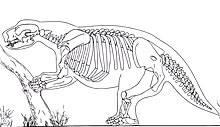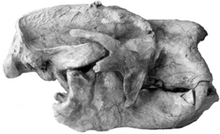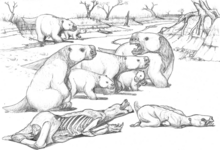You can help expand this article with text translated from the corresponding article in German. (June 2022) Click for important translation instructions.
|
| Lestodon Temporal range: Early Pliocene-Early Holocene (Montehermosan-Lujanian) ~5.332–0.10 Ma PreꞒ Ꞓ O S D C P T J K Pg N | |
|---|---|

| |
| L. armatus skeleton at the American Museum of Natural History | |
| Scientific classification | |
| Domain: | Eukaryota |
| Kingdom: | Animalia |
| Phylum: | Chordata |
| Class: | Mammalia |
| Order: | Pilosa |
| Family: | †Mylodontidae |
| Subfamily: | †Mylodontinae |
| Tribe: | †Lestodontini |
| Genus: | †Lestodon Gervais 1855 |
| Species | |
|
† L. armatus Gervais 1855, type | |
Lestodon is an extinct genus of giant ground sloth native to South America during the Pleistocene epoch. Its fossil remains have been primarily been found in the Pampas and adjacent regions. The largest member of the family Mylodontidae, It is estimated to have weighed 4,100 kilograms (4.5 short tons). It was a herbivore and primarily fed on the grasses and low-growing plants.
Research history and taxonomy
The genus Lestodon and the species Lestodon armatus was erected by Paul Gervais in 1855, based on a fragments of the upper and lower jaws with teeth found in Late Pleistocene deposits what is currently Buenos Aires Province, Argentina. The genus name, which means "thief tooth", is in reference to the large caniniform teeth at the front of the jaw. In 1934, a second species L. australis was erected by Lucas Kraglievich, but this is now regarded as a junior synonym of L. armatus. In 2004, two additional species L. urumaquensis and L. codorensis were described based on fossils found in Late Miocene/Early Pliocene aged deposits in Venezuela. However other authors have doubted the placement of these taxa in Lestodon, with later studies generally placing them in the separate genus Bolivartherium.
Lestodon is a member of the family Mylodontidae, meaning that its closest living relatives are two-toed sloths. Phylogeny of sloths based on DNA after Delsuc et al. 2019.
| Folivora (sloths) |
| ||||||||||||||||||||||||||||||||||||
Within Mylodontidae, Lestodon is considered to be a member of the subfamily Mylodontinae (when Scelidotheriidae is not considered a separate family). It is the titular genus of the tribe Lestodontini, which often aside from Lestodon, includes Thinobadistes, Lestobradys and Bolivartherium, though this grouping as a whole is not always recovered as monophyletic.
Description
Size

Lestodon armatus is the largest known mylodontid sloth. Volumetric estimates suggests a body mass of around 4,100 kilograms (9,000 lb), making it one of the largest known ground sloths, alongside the megatheres Megatherium and Eremotherium.
Skull

The skull of Lestodon armatus has a very wide muzzle. The premaxilllae are weakly attached to the maxillae (often resulting in them being absent in recovered fossils). The nasal septum was think and weak, and is rarely preserved. The nasal cartilage was apparently not ossified. The roof of the muzzle is marginally concave along its midline. The maxilla extends more towards the front of the skull on its lower part. The nasofrontal suture is U-shaped, and opens forwards. The foramen magnum is oval-shaped. The teeth were quite hypsodont (high-crowned), though not to the same degree as achieved in some other mylodontids. At the front of the mouth there were two pairs of tusk-like "caniniform" teeth on the upper and lower jaws which are separated from the molariform teeth by a large diastema (gap). The lower caniniform teeth appear to exhibit sexual dimorphism in regard to size. The molariform teeth are largely similar to each other, aside from the last lower molar "which has two rounded lobes separated by a narrow constriction giving it a figure-8 shape". There are 5 and 4 teeth in each half of the upper and lower jaw respectively, as is typical of mylodontids.
Axial skeleton
The first thoracic vertebra has a much higher neural spine than the seventh cervical vertebra.
Limbs
The olecranon process of the ulna of Lestodom armatus is slightly short compared to body size, though large in absolute terms. The tibia and fibula of L. armatus are fused together at the end closest to the hip (proximal). The tibia is relatively short compared to body size. Like many other ground sloths, the foot is inwardly rotated, meaning that the weight was borne on the outer digits of the foot as well as on the calcaneus. Like other ground sloths, the hands had ungual phalanges indicating well-developed claws.
Distribution
Lestodon armatus is primarily known from the Pampas and the Chaco-Paraná Basin, including what is now southern Brazil, Paraguay, Uruguay, and northern Argentina.
Ecology

Lestodon is generally regarded as having a grazing diet. Lestodon is thought to have been a bulk feeder that indiscriminately consumed large amounts of vegetation, using its probably square, white rhinoceros-like lips to pluck grass and other low lying plants in combination with the tongue. Isotopic analysis has suggested that Lestodon consumed a varying proportion of C3 and C4 plants, depending on locality. Although the proportions of its forelimbs are similar to those of mylodontids like Glossotherium that are suggested to have engaged in digging, the strength of its forelimb is much lower than those mylodontids, indicating that they were not substantially adapted to this task. If Lestodon engaged in digging at all, it may have engaged in it only in short intervals. Lestodon, like other ground sloths, was likely incapable of running from predators, instead relying on its claws to defend itself as living sloths do.
A bonebed of 13 Lestodon armatus individuals of different ages found together at the Playa del Barco site in Argentina suggests that the species engaged in gregarious behaviour, living at least some of the time in social groups. Analysis of the stapes of L. armatus suggests that they were adapted to hearing-low frequency sounds, suggesting that they may have communicated with each other using low frequency sound, like living elephants. It has been suggested based on the likely sexual dimorphism of the lower tusk-like caniniforms, that Lestodon armatus had a polygynous mating system, with males possibly engaging in combat with each other over females.
Relationship with humans and extinction
Researchers working at the Arroyo del Vizcaíno site near Sauce, Uruguay suggested that Lestodon was hunted by humans about 30,000 years ago. This was based on analysis of Lestodon bones. Deep slash markings on some of them were suggested to be from the use of human stone tools. However, there are no unambiguous stone tools at the site, and the supposed "cut marks" could easily have been generated by non-human activities, such as trampling. The site is also considerably older than the earliest widely accepted dates for human presence in South America (which dates to around 16–14,500 years ago).
Lestodon became extinct at the end of the Late Pleistocene as part of the Late Pleistocene megafauna extinctions, along with the vast majority of large mammals native to South America, including all of those above 500 kilograms (1,100 lb). Though from the Last Glacial Maximum to the Holocene climatic optimum the area of suitable habitat for Lestodon decreased, mostly as a result of raised sea levels, the greater habitat reduction during the Last Interglacial (which Lestodon survived) suggests that climate change was not the primary driver of the extinction of Lestodon. The extinction interval of Lestodon and other megafauna coincides with the appearance and abundance of Fishtail points, which are suggested to have been used to hunt megafauna, across the Pampas region and South America more broadly, which may have been a contributory factor in the extinctions. At the Paso Otero 5 site in the Pampas of northeast Argentina, Fishtail points are associated with burned bones of Lestodon and other extinct megafauna. The bones appear to have been deliberately burned as a source of fuel. Due to the poor preservation of the bones there is no clear evidence of human modification.
References
- Tomassini, Rodrigo L.; Montalvo, Claudia I.; Garrone, Mariana C.; Domingo, Laura; Ferigolo, Jorge; Cruz, Laura E.; Sanz-Pérez, Dánae; Fernández-Jalvo, Yolanda; Cerda, Ignacio A. (2020-07-02). "Gregariousness in the giant sloth Lestodon (Xenarthra): multi-proxy approach of a bonebed from the Last Maximum Glacial of Argentine Pampas". Scientific Reports. 10 (1): 10955. Bibcode:2020NatSR..1010955T. doi:10.1038/s41598-020-67863-0. hdl:10261/233402. ISSN 2045-2322. PMC 7331707. PMID 32616813.
- Gervais, P., 1855. Recherches sur les mammifères fossils de l′Amérique méridionale, Annales des Sciences Naturelles, Zoologie 3 (6) (1855), pp. 330–338.
- ^ Czerwonogora, Ada; Fariña, Richard A. (February 2013). "How many Pleistocene species of Lestodon (Mammalia, Xenarthra, Tardigrada)?". Journal of Systematic Palaeontology. 11 (2): 251–263. Bibcode:2013JSPal..11..251C. doi:10.1080/14772019.2012.660993. ISSN 1477-2019.
- ^ Fariña RA, Vizcaíno SF, de Iuliis G (2012). Megafauna: Giant Beasts of Pleistocene South America. Indiana University Press. pp. 212–213. ISBN 978-0-253-00230-3.
- Linares OJ. 2004. Nuevos restos del género Lestodon Gervais, 1855 (Xenarthra, Tardigrada, Mylodontidae), del Mioceno Tardío y Plioceno Temprano de Urumaco (Venezuela), con descripción de nuevas especies. . Paleobiologia Neotropical. 2:1–14.
- Rincón, Ascanio D.; McDonald, H. Gregory; Solórzano, Andrés; Flores, Mónica Núñez; Ruiz-Ramoni, Damián (February 2015). "A new enigmatic Late Miocene mylodontoid sloth from northern South America". Royal Society Open Science. 2 (2): 140256. Bibcode:2015RSOS....240256R. doi:10.1098/rsos.140256. ISSN 2054-5703. PMC 4448802. PMID 26064594.
- Delsuc, Frédéric; Kuch, Melanie; Gibb, Gillian C.; Karpinski, Emil; Hackenberger, Dirk; Szpak, Paul; Martínez, Jorge G.; Mead, Jim I.; McDonald, H. Gregory; MacPhee, Ross D.E.; Billet, Guillaume; Hautier, Lionel; Poinar, Hendrik N. (June 2019). "Ancient Mitogenomes Reveal the Evolutionary History and Biogeography of Sloths". Current Biology. 29 (12): 2031–2042.e6. Bibcode:2019CBio...29E2031D. doi:10.1016/j.cub.2019.05.043. hdl:11336/136908. PMID 31178321.
- Boscaini, Alberto; Pujos, François; Gaudin, Timothy J. (November 2019). "A reappraisal of the phylogeny of Mylodontidae (Mammalia, Xenarthra) and the divergence of mylodontine and lestodontine sloths". Zoologica Scripta. 48 (6): 691–710. doi:10.1111/zsc.12376. ISSN 0300-3256.
- Casali, Daniel M; Boscaini, Alberto; Gaudin, Timothy J; Perini, Fernando A (2022-11-28). "Reassessing the phylogeny and divergence times of sloths (Mammalia: Pilosa: Folivora), exploring alternative morphological partitioning and dating models". Zoological Journal of the Linnean Society. 196 (4): 1505–1551. doi:10.1093/zoolinnean/zlac041. ISSN 0024-4082.
- ^ Tomassini, Rodrigo L.; Montalvo, Claudia I.; Garrone, Mariana C.; Domingo, Laura; Ferigolo, Jorge; Cruz, Laura E.; Sanz-Pérez, Dánae; Fernández-Jalvo, Yolanda; Cerda, Ignacio A. (2020-07-02). "Gregariousness in the giant sloth Lestodon (Xenarthra): multi-proxy approach of a bonebed from the Last Maximum Glacial of Argentine Pampas". Scientific Reports. 10 (1): 10955. Bibcode:2020NatSR..1010955T. doi:10.1038/s41598-020-67863-0. ISSN 2045-2322. PMC 7331707. PMID 32616813.
- ^ Bargo, M. Susana; Vizcaíno, Sergio F.; Archuby, Fernando M.; Blanco, R. Ernesto (2000-09-25). "Limb bone proportions, strength and digging in some Lujanian (Late Pleistocene-Early Holocene) mylodontid ground sloths (Mammalia, Xenarthra)". Journal of Vertebrate Paleontology. 20 (3): 601–610. doi:10.1671/0272-4634(2000)020[0601:LBPSAD]2.0.CO;2. ISSN 0272-4634.
- McDonald, H. Gregory (June 2023). "A Tale of Two Continents (and a Few Islands): Ecology and Distribution of Late Pleistocene Sloths". Land. 12 (6): 1192. doi:10.3390/land12061192. ISSN 2073-445X.
- ^ Bargo, M. Susana; Toledo, Néstor; Vizcaíno, Sergio F. (February 2006). "Muzzle of South American Pleistocene ground sloths (Xenarthra, Tardigrada)". Journal of Morphology. 267 (2): 248–263. doi:10.1002/jmor.10399. ISSN 0362-2525. PMID 16315216.
- Bargo, M. S., G. De Iuliis, and S. F. Vizcaino. 2006. Hypsodonty in Pleistocene ground sloths. Acta Palaeontol. Pol. 51: 53.
- ^ Varela, Luciano; McDonald, H. Gregory; Fariña, Richard (2022-03-04). "Sexual dimorphism in the fossil ground sloth Lestodon armatus (Xenarthra, Folivora)". Historical Biology. 34 (3): 525–537. Bibcode:2022HBio...34..525V. doi:10.1080/08912963.2021.1933470. ISSN 0891-2963.
- Tambusso, P. Sebastián; Fariña, Richard A. (2021-09-02). "Ground sloth vertebrae identification through multivariate analysis". Historical Biology. 33 (9): 1412–1421. Bibcode:2021HBio...33.1412T. doi:10.1080/08912963.2019.1700241. ISSN 0891-2963.
- Vargas-Peixoto, Dilson; Colusso, Cícero Schneider; Da-Rosa, Átila Augusto Stock; Kerber, Leonardo (2021-02-01). "A new record of Lestodon armatus Gervais 1855 (Xenarthra, Mylodontidae) from the Quaternary of southern Brazil and remarks on its postcranial anatomy". Historical Biology. 33 (2): 159–175. Bibcode:2021HBio...33..159V. doi:10.1080/08912963.2019.1597075. ISSN 0891-2963.
- ^ McDonald, H. Gregory (September 2012). "Evolution of the Pedolateral Foot in Ground Sloths: Patterns of Change in the Astragalus". Journal of Mammalian Evolution. 19 (3): 209–215. doi:10.1007/s10914-011-9182-x. ISSN 1064-7554.
- ^ Patiño, Santiago J.; Fariña, Richard A. (2017-11-17). "Ungual phalanges analysis in Pleistocene ground sloths (Xenarthra, Folivora)". Historical Biology. 29 (8): 1065–1075. Bibcode:2017HBio...29.1065P. doi:10.1080/08912963.2017.1286653. ISSN 0891-2963.
- ^ Varela, Luciano; Fariña, Richard A. (January 2016). "Co-occurrence of mylodontid sloths and insights on their potential distributions during the late Pleistocene". Quaternary Research. 85 (1): 66–74. Bibcode:2016QuRes..85...66V. doi:10.1016/j.yqres.2015.11.009. ISSN 0033-5894.
- Varela, Luciano; Tambusso, P. Sebastián; Patiño, Santiago J.; Di Giacomo, Mariana; Fariña, Richard A. (December 2018). "Potential Distribution of Fossil Xenarthrans in South America during the Late Pleistocene: co-Occurrence and Provincialism". Journal of Mammalian Evolution. 25 (4): 539–550. doi:10.1007/s10914-017-9406-9. ISSN 1064-7554.
- Saarinen, Juha (2019), Gordon, Iain J.; Prins, Herbert H. T. (eds.), "The Palaeontology of Browsing and Grazing", The Ecology of Browsing and Grazing II, Ecological Studies, vol. 239, Cham: Springer International Publishing, pp. 5–59, doi:10.1007/978-3-030-25865-8_2, ISBN 978-3-030-25864-1, retrieved 2024-05-15
- Czerwonogora, A., Fariña, R.A. & Tonni, E.P. (2011): Diet and isotopes of Late Pleistocene ground sloths: first results for Lestodon and Glossotherium (Xenarthra, Tardigrada). – N. Jb. Geol. Paläont. Abh., 262: 257–266; Stuttgart.
- Varela, Luciano; Clavijo, Lucía; Tambusso, P. Sebastián; Fariña, Richard A. (October 2023). "A window into a late Pleistocene megafauna community: Stable isotopes show niche partitioning among herbivorous taxa at the Arroyo del Vizcaíno site (Uruguay)". Quaternary Science Reviews. 317: 108286. Bibcode:2023QSRv..31708286V. doi:10.1016/j.quascirev.2023.108286.
- Blanco, R. Ernesto; Rinderknecht, Andrés (November 2012). "Fossil evidence of frequency range of hearing independent of body size in South American Pleistocene ground sloths (Mammalia, Xenarthra)". Comptes Rendus Palevol. 11 (8): 549–554. Bibcode:2012CRPal..11..549B. doi:10.1016/j.crpv.2012.07.003.
- Richard A. Fariña et al., Arroyo del Vizcaíno, Uruguay: a fossil-rich 30-ka-old megafaunal locality with cut-marked bones, Proceedings of the Royal Society B: Biological Sciences, Published 20 November 2013, doi:10.1098/rspb.2013.2211
- Suárez, Rafael; Borrero, Luis A.; Borrazzo, Karen; Ubilla, Martín; Martínez, Sergio; Perea, Daniel (2014-11-22). "Archaeological evidences are still missing: a comment on Fariña et al. Arroyo del Vizcaíno site, Uruguay". Proceedings of the Royal Society B: Biological Sciences. 281 (1795): 20140449. doi:10.1098/rspb.2014.0449. ISSN 0962-8452. PMC 4213605. PMID 25297857.
- Holcomb, Justin A.; Mandel, Rolfe D.; Otárola-Castillo, Erik; Rademaker, Kurt; Rosencrance, Richard L.; McDonough, Katelyn N.; Miller, D. Shane; Wygal, Brian T. (2022-10-02). "Does the evidence at Arroyo del Vizcaíno (Uruguay) support the claim of human occupation 30,000 years ago?". PaleoAmerica. 8 (4): 285–299. doi:10.1080/20555563.2022.2135476. ISSN 2055-5563.
- Svenning, Jens-Christian; Lemoine, Rhys T.; Bergman, Juraj; Buitenwerf, Robert; Le Roux, Elizabeth; Lundgren, Erick; Mungi, Ninad; Pedersen, Rasmus Ø. (2024). "The late-Quaternary megafauna extinctions: Patterns, causes, ecological consequences and implications for ecosystem management in the Anthropocene". Cambridge Prisms: Extinction. 2. doi:10.1017/ext.2024.4. ISSN 2755-0958.
- Prates, Luciano; Perez, S. Ivan (2021-04-12). "Late Pleistocene South American megafaunal extinctions associated with rise of Fishtail points and human population". Nature Communications. 12 (1): 2175. Bibcode:2021NatCo..12.2175P. doi:10.1038/s41467-021-22506-4. ISSN 2041-1723. PMC 8041891. PMID 33846353.
- G. Martínez, M. A. Gutiérrez, Paso Otero 5: A summary of the interdisciplinary lines of evidence for reconstructing early human occupation and paleoenvironment in the Pampean region, Argentina, in Peuplements et Préhistoire de l’Amérique, D. Vialou, Ed. (Muséum National d’ Histoire Naturelle. Departement de Prehistoire, U.M.R, Paris, 2011), pp. 271–284.
| Taxon identifiers | |
|---|---|
| Lestodon | |
- Prehistoric sloths
- Prehistoric placental genera
- Pliocene xenarthrans
- Pleistocene xenarthrans
- Pliocene mammals of South America
- Pleistocene mammals of South America
- Lujanian
- Ensenadan
- Montehermosan
- Neogene Argentina
- Neogene Venezuela
- Fossils of Venezuela
- Pleistocene Argentina
- Fossils of Argentina
- Pleistocene Bolivia
- Fossils of Bolivia
- Pleistocene Brazil
- Fossils of Brazil
- Pleistocene Paraguay
- Fossils of Paraguay
- Pleistocene Uruguay
- Fossils of Uruguay
- Fossil taxa described in 1855

